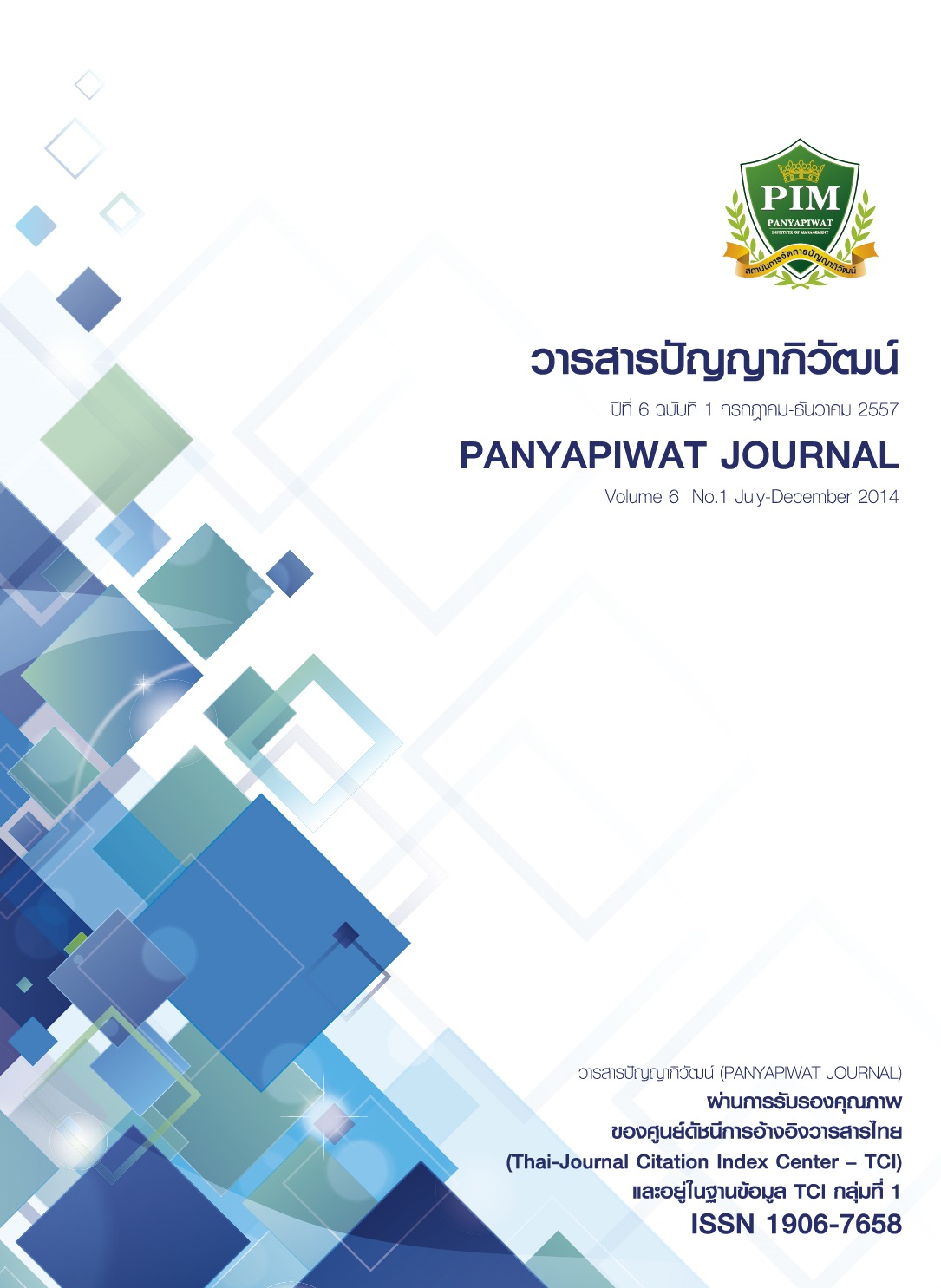แนวทางการพัฒนาศักยภาพโลจิสติกส์ของกลุ่มประเทศ ลุ่มน้ำโขงสู่ประชาคมเศรษฐกิจอาเซียน: ท่าเรือเชียงแสน
Main Article Content
บทคัดย่อ
บทคัดย่อ
แนวทางการพัฒนาศักยภาพโลจิสติกส์ของท่าเรือเชียงแสนกลุ่มประเทศลุ่มน้ำโขงสู่ประชาคมเศรษฐกิจอาเซียน มีวัตถุประสงค์เพื่อศึกษาบริบทและแนวทางการพัฒนาศักยภาพโลจิสติกส์ของท่าเรือเชียงแสนและนำผลที่ได้มาพัฒนาและปรับปรุงเพื่อให้เกิดความยั่งยืนของการดำเนินงานด้านโลจิสติกส์ท่าเรือเชียงแสนกลุ่มประเทศลุ่มน้ำโขง
สู่ประชาคมเศรษฐกิจอาเซียนการวิจัยครั้งนี้เป็นการวิจัยเชิงคุณภาพ โดยใช้การสัมภาษณ์แบบเจาะลึกเป็นรายบุคคล(Individual-Depth Interviews) ของกลุ่มผู้นำทางความคิด (Key Opinion Leaders) ใช้วิธีเจาะจงในการเลือกกลุ่มตัวอย่าง ได้แก่ เจ้าหน้าที่ที่เกี่ยวข้องกับการดำเนินงานด้านโลจิสติกส์ท่าเรือเชียงแสน ตัวแทนผู้บริหารธุรกิจขนาดกลางและขนาดเลก็ ทีป่ ระสบความสำเรจ็ เปน็ ทีย่ อมรบั ของกลมุ่ ธุรกิจด้านโลจิส ติกส์ผู้บริหารสมาคมหรือ ผู้กำหนดนโยบายบริหารจัดการกลุ่มธุรกิจด้านโลจิสติกส์ของภาครัฐ จำนวน 20 ราย ผลการศึกษา พบว่าความหมายของประชาคมเศรษฐกิจอาเซียนของกลุ่มตัวอย่างนั้น มีจุดมุ่งหมายเพื่อมุ่งให้อาเซียนเป็นตลาดและฐานการผลิตเดียวกันรวมถึงการใช้ทรัพยากรให้เกิดประโยชน์สูงสุด การเข้าเมืองของแรงงาน (คน) เงินทุนเสรี สามารถค้าขายด้วยเงินสกุลต่างๆ ของอาเซียนโดยไม่มีข้อจำกัด สามารถซื้อขายหุ้นข้ามชาติได้อย่างเสรี ไม่จำกัดขอบเขตการแข่งขันบริการโดยทั้ง 10 ประเทศ เป็นตลาดและฐานผลิตเดียวที่มีการเคลื่อนย้ายสินค้า บริการ และการลงทุนแรงงานฝีมือและเงินทุนอย่างเสรี แนวทางการพัฒนาด้านโลจิสติกส์ในเขตภาคเหนือของประเทศไทย เพื่อนำไปสู่ความยั่งยืน คือ 1) สร้างกลยุทธ์ความได้เปรียบทางการแข่งขันด้านโลจิสติกส์ มุ่งเน้นการสร้าง Economies of Scope ความสามารถในการลดต้นทุนโดยใช้ทรัพยากรร่วมกันของหน่วยงานต่างๆ ซึ่งมุ่งการบริหารจัดการต้นทุน ด้านพลังงาน ด้านสิ่งแวดล้อมและการประกันความเสี่ยง 2) ประยุกต์ใช้ระบบสารสารเทศและเทคโนโลยี เพื่อการบริหารจัดการด้านโลจิสติกส์ควรจัดการบริหารความได้เปรียบทางการแข่งขันเพื่อความสำเร็จในการดำเนินงานโดยการสร้างและพัฒนานวัตกรรมใหม่และการมุ่งเน้นการจัดการยุคใหม่ประยุกต์ใช้นวัตกรรมและเทคโนโลยีต่างๆ เพื่อเพิ่มประสิทธิภาพของด้านโลจิสติกส์และ 3) การพัฒนาด้านการตลาดโลจิสติกส์ โดยใช้ความร่วมมือเครือข่ายภาครัฐและเอกชน ภายในประเทศและต่างประเทศ เพื่อเพิ่มรายได้
Abstract
The objective of the study was to identify the potential logistics development ChiangSaen Port Great Mae Khong Sub-Region countries for ASEAN Economic Community approach. Then use the finding to develop and improve the sustainability of logistics operation at Chiang Saen Port. It was qualitative research. The research tool was done by Individual-Depth Interviews with 20 Key Opinion Leaders by Purposive or Judgmental Sampling which consistedofChiang Saen Port logistic officers, representative of successful SMEs business in logistic market, and board of management in logistic business of public sectors. The result of the study shown that ASEAN Economic Community aimed to integrate ASEAN to be a single market and production base,including the use of resources to maximize benefit achievement benefit, free migration, and capital liberalized, no restrictionon trading with ASEAN’s currencies, free multinational stock trading, and no limitation
on service competition. All these treats lead ten member countries to be a free single production base in transporting products, services, investments, labor and fund. It is also influenced to the development approach in Northern Thailand’s logistics. In order to contribute to sustainability, the development should focus on 1) Create a competitive advantage strategy in logistics with a focus on creating Economies of Scope to be able to reduce costs by sharing resources between various organizations which aims to manage cost, energy, environment and risk insurance. 2) Apply to use Information System and technology in logistics management to achieve competitive advantage for successful operation by creating and develop new innovation. As well as focusing on modern management by applying innovation and new technology to increase the efficiency of logistics. And 3.) Logistics development should be cooperated by public and private sectors, domestic and international network to resolve the problem of rules, regulations, and promotion to create the fairness among ASEAN member states.
Article Details
“ข้าพเจ้าและผู้เขียนร่วม (ถ้ามี) ขอรับรองว่า บทความที่เสนอมานี้ยังไม่เคยได้รับการตีพิมพ์และไม่ได้อยู่ระหว่างกระบวนการพิจารณาลงตีพิมพ์ในวารสารหรือแหล่งเผยแพร่อื่นใด ข้าพเจ้าและผู้เขียนร่วมยอมรับหลักเกณฑ์การพิจารณาต้นฉบับ ทั้งยินยอมให้กองบรรณาธิการมีสิทธิ์พิจารณาและตรวจแก้ต้นฉบับได้ตามที่เห็นสมควร พร้อมนี้ขอมอบลิขสิทธิ์บทความที่ได้รับการตีพิมพ์ให้แก่สถาบันการจัดการปัญญาภิวัฒน์หากมีการฟ้องร้องเรื่องการละเมิดลิขสิทธิ์เกี่ยวกับภาพ กราฟ ข้อความส่วนใดส่วนหนึ่งและ/หรือข้อคิดเห็นที่ปรากฏในบทความข้าพเจ้าและผู้เขียนร่วมยินยอมรับผิดชอบแต่เพียงฝ่ายเดียว”
References
กรมอาเซียน กระทรวงต่างประเทศ. (2555). ความเป็นมาของอาเซียน. สืบค้นเมื่อ 9 ตุลาคม 2555, จาก http://www.mfa.go.th/web/3030.
การท่าเรือแห่งประเทศ. (2554). การนําเสนอการดําเนินงานท่าเรือเชียงแสน. เชียงราย: กรมเจ้าท่า ท่าเรือเชียงแสน 2 เชียงราย, รายวิชา การบริหารโครงการ รัฐประศาสนาศาสตร์มหาบัณฑิต มหาวิทยาลัยราชภัฏเชียงราย.
จักรกฤษณ์ ดวงพัสตรา. (2556). การพัฒนาศักยภาพผู้ให้บริการโลจิสติกส์ไทยสู่ประชาเศรษฐกิจอาเซียน. วารสารวิทยาการจัดการ, 30(2), 81.
สุภจิตร ปัญญามิตร. (2548). ผลกระทบจากการจัดตั้งเขตการค้าเสรีในมุมมองของโลจิสติกส์. บัณฑิตวิทยาลัยการจัดการและนวัตกรรม.มหาวิทยาลัยเทคโนโลยีพระจอมเกล้าธนบุรี.
ASEAN Secretariat. (2010). Roadmap for the Integration of Logistics Services. Retrieved August 8, 2012, from www.aseansec.org/20883.pdf. (8, 2012)
Barney, Jay B. (1991). Firm Resources and Sustained Competitive Advantage. Journal of Management,17(1), 99-120.
Bartol, Kathryn M. & Martin, David C. (1994). Management. 2nded. New York : McGraw-Hill, Inc.
Porter, Michael E, (1980). Competitive Strategy: Techniques for Analyzing Industries and Competitors. New York: Free Press.
Siew Yean Tham. (2008). ASEAN Open Skies and the Implications for Airport. Manila: Development StrategyIn Malaysia, Asian Development Bank.
Ziqi Liao, & Greenfield, PaulF. (2000). The Synergy of Corporate R&D and Competitive Strategies: An Exploratory Study in Australian High-Technology Companies. The Journal of High Technology Management Research, 11(1), 93-107.

